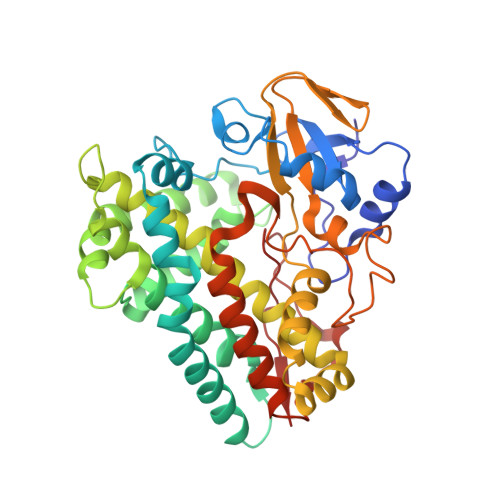Molecular basis of regio- and stereo-specificity in biosynthesis of bacterial heterodimeric diketopiperazines.
Sun, C., Luo, Z., Zhang, W., Tian, W., Peng, H., Lin, Z., Deng, Z., Kobe, B., Jia, X., Qu, X.(2020) Nat Commun 11: 6251-6251
- PubMed: 33288748
- DOI: https://doi.org/10.1038/s41467-020-20022-5
- Primary Citation of Related Structures:
6VXV, 6VZA, 6VZB, 6W0S - PubMed Abstract:
Bacterial heterodimeric tryptophan-containing diketopiperazines (HTDKPs) are a growing family of bioactive natural products. They are challenging to prepare by chemical routes due to the polycyclic and densely functionalized backbone. Through functional characterization and investigation, we herein identify a family of three related HTDKP-forming cytochrome P450s (NasbB, Nas S1868 and Nas F5053 ) and reveal four critical residues (Qln65, Ala86, Ser284 and Val288) that control their regio- and stereo-selectivity to generate diverse dimeric DKP frameworks. Engineering these residues can alter the specificities of the enzymes to produce diverse frameworks. Determining the crystal structures (1.70-1.47 Å) of Nas F5053 (ligand-free and substrate-bound Nas F5053 and its Q65I-A86G and S284A-V288A mutants) and molecular dynamics simulation finally elucidate the specificity-conferring mechanism of these residues. Our results provide a clear molecular and mechanistic basis into this family of HTDKP-forming P450s, laying a solid foundation for rapid access to the molecular diversity of HTDKP frameworks through rational engineering of the P450s.
Organizational Affiliation:
State Key Laboratory of Microbial Metabolism and School of Life Sciences and Biotechnology, Shanghai Jiao Tong University, 200240, Shanghai, China.


















